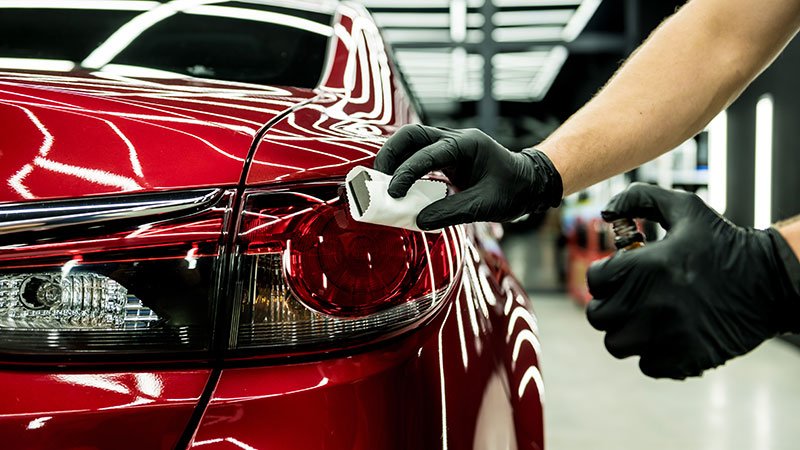A Comprehensive Overview to the Sorts Of Ceramic Covering on the Market
Ceramic coatings have arised as a critical remedy throughout various industries due to their unique buildings and applications. As we check out the distinct features and applications of these finishings, the implications for performance and long life come to be progressively apparent, increasing concerns about which type might best suit your demands.
Understanding Ceramic Coatings
Ceramic coatings are advanced safety options that have obtained popularity in different markets, especially in automotive and aerospace applications. These finishings include a liquid polymer that, when treated, develops a long lasting, hydrophobic layer on the surface of the substratum. This layer offers enhanced resistance to environmental contaminants, UV radiation, and chemical direct exposure, thereby prolonging the life and visual appeal of the underlying product.
The basic element of ceramic finishes is silica, which adds to their firmness and longevity. The application process typically involves surface area preparation, application of the coating, and healing, which can be accomplished via warmth or UV light. When cured, ceramic coverings exhibit extraordinary bonding buildings, permitting them to stick strongly to a variety of surface areas, consisting of metals, plastics, and glass.
Along with their protective functions, ceramic coverings additionally offer ease of maintenance. Their hydrophobic nature reduces the adherence of dust and grime, making cleaning easier and much less frequent. Generally, the adoption of ceramic coverings represents a substantial innovation in surface area defense modern technology, providing both useful and visual advantages throughout numerous sectors.
Types of Ceramic Coatings
Numerous sorts of ceramic coatings are available, each developed to fulfill specific efficiency requirements and applications - Car Detailing. One of the most usual types consist of:
Silica-based Coatings: These layers mostly include silicon dioxide and are known for their sturdiness and chemical resistance. They are extensively used in automobile and commercial applications.
Titanium Dioxide Coatings: Renowned for their photocatalytic residential properties, titanium dioxide coverings are typically used in environments where self-cleaning and antifungal buildings are preferable, such as in building products and auto finishes.
Zirconia Coatings: Defined by their high-temperature security and thermal resistance, zirconia coatings are made use of in applications such as turbine engines and high-performance vehicle parts.
Alumina Coatings: Displaying exceptional hardness and thermal security, alumina coverings are frequently made use of in wear-resistant applications, including cutting devices and commercial machinery. - Auto Detailing
Crossbreed Coatings: Integrating the properties of various products, crossbreed finishes offer improved performance characteristics, making them suitable for one-of-a-kind and demanding applications.
Each kind of ceramic coating offers unique objectives, allowing individuals to pick one of the most appropriate remedy based upon certain ecological conditions and efficiency demands.
Benefits of Ceramic Coatings
Ceramic finishings, in certain, offer countless advantages that make them increasingly popular amongst manufacturers and consumers alike. These finishings are immune to scratches, chemicals, and UV rays, making certain that the underlying surface stays safeguarded over time.
In addition to durability, ceramic finishes provide superb hydrophobic buildings, permitting easy cleansing and upkeep. This water-repellent nature reduces the adherence of dirt, crud, and various other impurities, which can lengthen the visual charm and performance of the surface area. Moreover, ceramic layers can considerably improve thermal resistance, making them suitable for applications you can try these out that endure heats.

Application Refine
When using ceramic finishes, a careful technique is important to attain ideal results. The application procedure normally begins with comprehensive surface preparation. This involves washing, sanitizing, and polishing the surface area to get rid of all contaminations, consisting of dust, grease, and prior waxes or sealers. A tidy surface area guarantees correct bond of the finishing.
Once the surface area is prepped, the next action is to apply the ceramic coating. This can be done making use of an applicator pad or a microfiber towel, making certain even coverage. It is web critical to work in small areas to keep control and stop early curing. The coating ought to be applied in slim layers, as thicker applications can lead to uneven finishes.
After application, the covering requires a particular curing time, usually varying from a couple of hours to a full day, depending upon the item. During this time, it is essential to stay clear of exposure to moisture or contaminants. A mild buffing might be needed after curing to improve the gloss and remove any kind of high places. Complying with these steps faithfully will make the most of the effectiveness and longevity of the ceramic layer, offering a resilient protective layer for the surface area.
Upkeep and Longevity
To guarantee the long life and performance of a ceramic coating, routine upkeep is essential. Ceramic finishes, recognized for their resilience and protective top qualities, call for particular treatment regimens to optimize their lifespan and performance.
In enhancement to normal washing, regular examinations are vital. Look for indicators of wear or damage, helpful site such as hydrophobic residential or commercial properties diminishing or surface blemishes. If needed, a light polish may be used to rejuvenate the covering without stripping it away.
Furthermore, the application of a booster spray can enhance the finishing's hydrophobic impacts and recover its gloss. This is particularly valuable for coatings that have actually remained in usage for an extended duration. Ultimately, by adhering to these maintenance techniques, one can significantly prolong the life of a ceramic finish, making sure that it continues to offer optimal protection against environmental elements and preserve the visual appeal of the car.
Final thought
